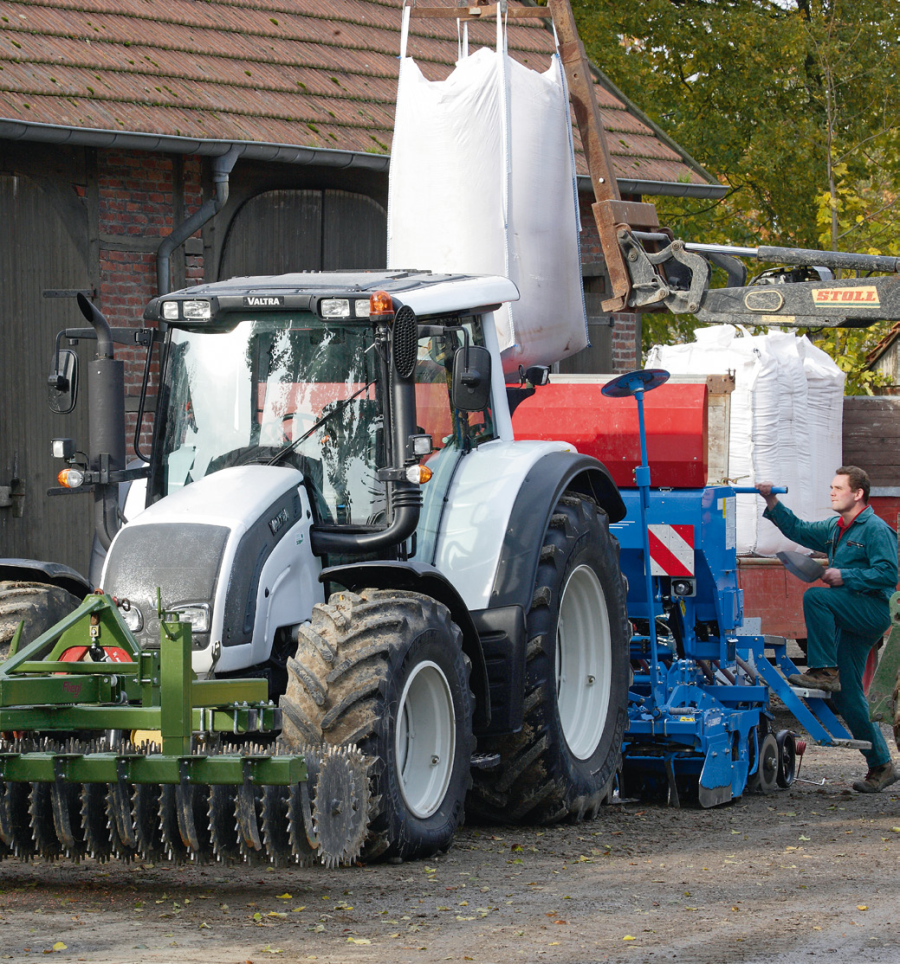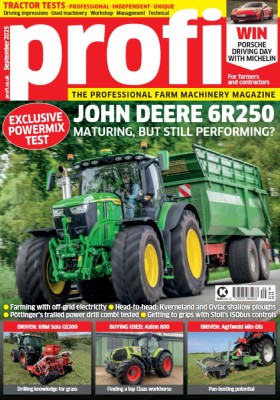When it came to developing a CVT, Valtra must have been tempted by the obvious route – of dipping into the AGCO parts store and slipping a ready-made Vario box into its tractor range. Instead, the Finnish company decided to design its own. A wise move? We find out here as the four cylinder N142 Direct enjoys the full profi test treatment
At the back-end of last year we put Valtra’s six-cyl powershift T182 Versu model through our profi tractor test, and now it’s the turn of the CVT-equipped four-cylinder N142 Direct. For the UK and Irish market there seems to be a growing acceptance of more powerful four-pot power rockets, which, Valtra says, in its case is helped by having a healthy displacement – 4.9 litres, to be precise – giving the ‘little’ lump more bite to its four-cylinder bark.
Poring over the brochure stats we see the N142’s four-cylinder, four-valve, commonrail injection Sisu 49CWA-4V motor knocks out 110kW/150hp at rated speed, before reaching a max output of 112kW/152hp at 2,000rpm. The outputs move up a notch for transport and pto work, when an additional 6kW/8hp is on tap.
All very useful stuff and, according to Valtra, are stats that make the CVT version an ideal machine for powering a clod/stone separator or potato harvester, where its shorter wheelbase results in tighter headland turns and the potential to grow a few more extra rows of crop. Ultimately, though, the decision to opt for Direct CVT or Versu semi-powershift is likely to boil down to an assessment of whether infinite speed range capability is genuinely necessary and if spending the additional money is likely to be recouped by an improvement in overall economy.
Power-wise, the N142 did not disappoint on the DLG test bench, where we measured 99.4kW/133.3hp at the pto shaft when the engine reached its rated speed; at 1,900rpm, output rose to 109.0kW/146.2hp (7.0kW/ 9.4hp thanks to ‘boost’).
The torque rise of 41% and a constant power range of nearly 30% are equally creditable especially when you note the 131% drive-off torque.
The fuel consumption figures, on the other hand, are less impressive. At rated speed we recorded 286g/kWh and 254g/kWh at maximum output on the pto, which is up to 10% more than other tractors in this power bracket. And things didn’t get much better during the drawbar test: even with a CVT the N142 worked up a thirst, drinking 334g/ kWh and 300g/kWh, but 84.6kW/113.4hp drawbar power at rated and 92.4kW/123.9hp at max speed are decent enough results.
In our more ‘real-world’ Powermix tests the Valtra engine and transmission fared better. These tests simulate field work, in which the load is constantly changing, so the engine and transmission need to respond and interact. The N142 Direct managed this pretty well, finishing up with an average of 308g/ kWh. That’s still 2.2% above the regular fuel consumption rate and a fraction over the average result obtained from all our previous Powermix tests – but not bad.
Looking at the transmission in a little more detail, Valtra’s Direct CVT is very closely linked to the firm’s Versu powershift box. Two multi-plate clutches are replaced by a hydrostatic pump and motor, which work with two powershift ranges and a planetary gear to provide stepless speed adjustment. There are still four ranges: 0 to 8km/hr (A), 0 to 17km/hr (B), 0 to 26km/hr (C) or 0 to 50km/hr (D) – which can be chosen to suit the job in hand. Range A is aimed at very heavy draft tasks, while B is better suited to loader duties. Range C is a more all-round ratio.
It’s simple to jump on a ‘Direct’ model and get the tractor moving without having to wade through the instruction manual. Nonetheless, if you want to make the most of the transmission’s many features, then some bedtime reading will undoubtedly pay off. Thankfully, the test machine was supplied with a quick reference guide, which assists users in understanding the various icons and what they have to offer.
We did find the transmission response in some instances a little ‘soft’, which may be welcomed by unfamiliar operators but soon becomes an irritation on routine work. For example, when the operator is looking to pull away swiftly, the engine has to increase its revs before the transmission will ease up through the ‘ratios’.
Just as frustrating is when you forget to activate the cruise control memory after starting the engine or when the automatic park brake has kicked in after the machine has stood still for more than 30 seconds, such as when waiting alongside a forager. Before you can move off again, the powershuttle must be shifted to ‘park’ and then the desired direction of travel selected.
Changing travel ranges makes sense – something we noticed when towing a laden trailer up a steep slope. Here you would go from D down to C to ensure a quick hill climb, which means the tractor also benefits from its boost being engaged at 6km/hr rather than the 15km/hr of the higher ratio. And it helps with regards to economy to realise that it isn’t always best to stick with the ratio with the widest working speed range, because there are two specific points within each range that offer optimum efficiency.
To figure out which range is the most suitable, the operator has to keep one eye on the fuel use meter. Flicking a switch enables the operator to simply swap to pedal mode with the engine and transmission management in semi-auto.
In this mode each pedal position is aligned to a speed and ratio, set on a small lever that also adjusts the speed band when in auto mode. In manual mode the operator can change the transmission speed with the lever and the engine speed with the foot pedal. Our only on-test grumble here is that we’d have appreciated being able to select manual mode more readily when driving alongside the forager.
Back at the rear, there are slim pickings in the pto department, with buyers having the option of just 540/1,000 or 540E/1,000. Our other gripe is with the auto pto, which on our test tractor disengaged the shaft as the linkage was raised but didn’t re-engage it when the lift arms were lowered back into work again. This action (or lack of action) is prompted by the operator flicking the quicklift switch, yet it’s time-based rather than happening when the lift arms are at 50% lift height or similar. Valtra says that operators can program the U-Pilot headland management system for turning the pto on and off with the linkage, this then addressing all of the above criticisms.
While on linkage matters, lift capacity actually decreases as the arms are raised – not helpful. Thankfully, capacities are high in the first place, so hoisting implements such as our 3.8t cultivator drill didn’t pose too much of a problem for the test tractor.
The N-series’s hydraulic system – a traditional Valtra strong point – receives more praise here. Our test machine was equipped with the £105 optional swash plate pump, which provided up to 156.6 litres/min. This helped the N142 Direct to achieve an excellent 43.6kW from its hydraulic system on the test bench. Up to 40 litres are available solely for hydraulics, as the transmission oil is kept separate.
Spool valves are aplenty with three at the front and four at the rear, and there are two additional on/off valves as well as power beyond couplers. And the icing on the supply cake is Valtra’s Hydraulic Assistant, which increases engine speed whenever a higher oil demand is detected. All hydraulic connectors are clearly marked and neatly arranged at the rear, although not all operators will appreciate Valtra’s angled positioning of its couplers either side of the top link, making it almost impossible to attach all the hoses from one side of the machine.
Another issue is that the armrestmounted cross-control lever operates only two spools at the front or rear. This means the operator isn’t able to use the cross controller to operate a front-mounted press and the markers on a rear-mounted drill at the same time. We also missed the lever not having a notched detent to indicate that it’s in float position.
While the transmission may be all-Valtra, the front-axle suspension hails from the Fendt 300-series, a sourcing arrangement that has been in place since the N-series was launched in 2005. This layout gives a soft ride and a tight 12m turn with 5.2m/s² braking – all good stuff.
Our full spec test model weighed in at 6,650kg, leaving a payload of 3,350kg courtesy of the 10t gross weight. Sensibly laid out steps and substantial grab armrest-mounted monochrome display, in particular, is tricky to see in bright sunlight. Intuitive operation isn’t helped by the plethora of buttons, which are often identical and, as a rule, not arranged logically on the armrest or the side console.
Countering the above points, at least in part, are the cab’s excellent backlighting of all the controls and its effective heating system.
Summary
We reckon there’s still room for improvement when it comes to the N142’s engine and transmission ‘talking’ with one another – to make the tractor act and feel more responsive – but we expect the Finns to put this right in the near future. Indeed, looking ahead to later in the year, a number of improvements are already on their way for N2/T2 models: a colour screen with night and day settings; pto and 4WD activation from the armrest; and a cruise memory retained after switch-off and possible activation from 0km/hr.
It will also be possible to operate both a front and rear spool together using the armrest cross controller. Sadly, though, the need for a larger processor means this list of new features can’t be retrofitted to existing tractors.
For more up-to-date farming news and reviews click here and subscribe now to profi for just £3.99 an issue.






